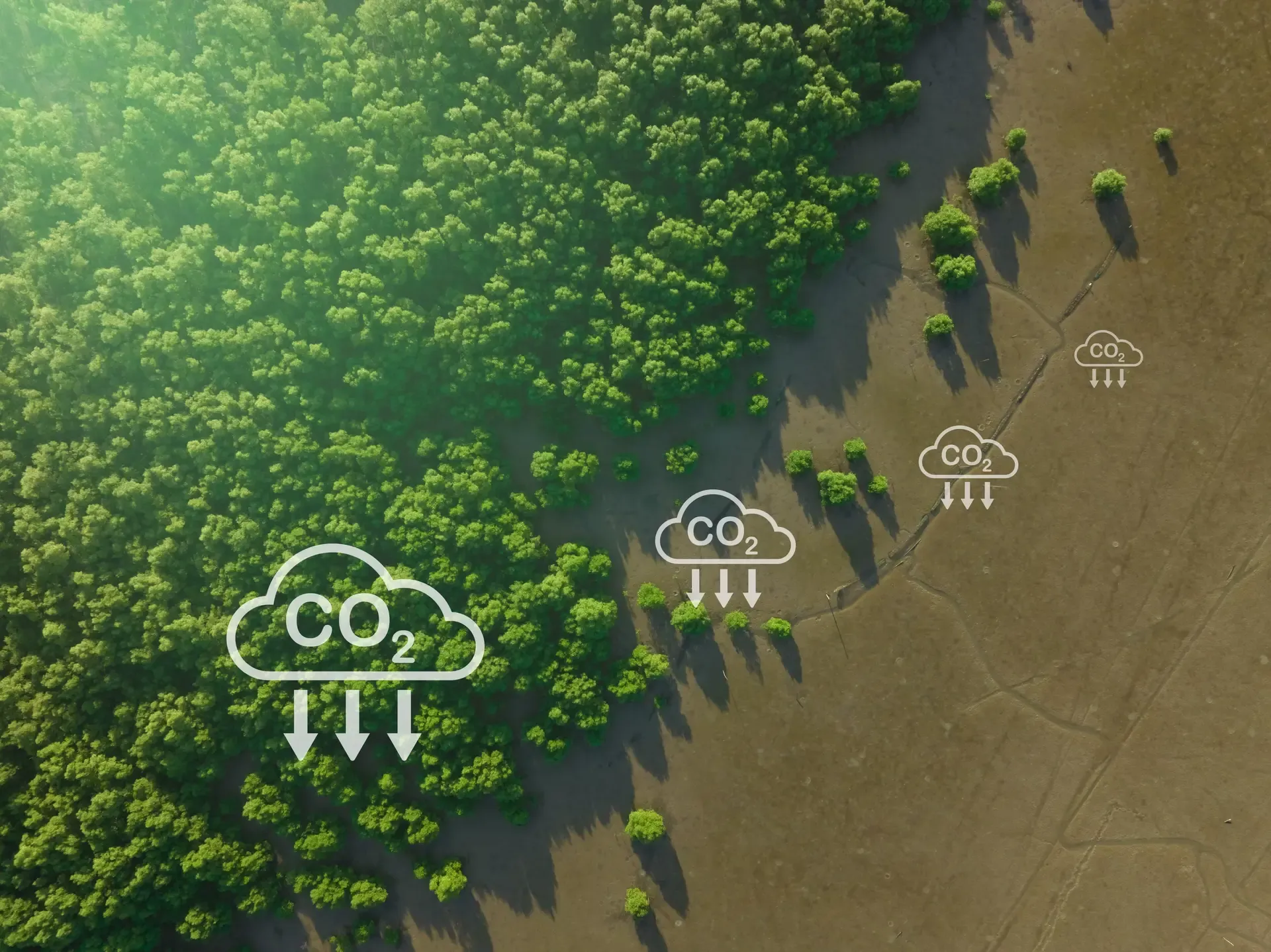FEATURE: Could Dynamic Baselines Help Alleviate Over-Crediting Concerns?

Aerial view of green forests showing carbon capture concept of a natural carbon sinks.
This Story Was Originally Published in QC Intel:
Quantum Commodity Intelligence – The voluntary carbon market has been the focus of a number of critical reports in recent months, questioning whether credits generated are genuine. Robin Lancaster explores one possible approach – dynamic baselines – that could help with over-crediting concerns.
Dynamic baselines are being touted by several carbon market participants as a potential answer to criticism of project over-crediting, particularly for forestry developments, although some people suggest a dynamic approach could also be used in other industry sectors.
Unlike static baselines, used by most carbon credit project methodologies and that rely on the past as a predictor of future outcomes, dynamic baselines do not attempt to predict the future and rely instead on constant monitoring and frequent data updates.
Project Reviews
In July, Kyle Arvisais, forest carbon scientist at Renoster, said in a company blog that the US carbon ratings agency is using a dynamic baseline for its project reviews “up until the most recent data is available before switching to a predictive model."
Arvisais said: “We provide a dynamic baseline score in each of our reviews to compare with the project’s baseline over that same time period, and we often and the project’s baselines to be too aggressive. “We strongly believe projects would be better off deploying dynamic baselines moving forward, and we believe the tide is shifting in that direction.”
A month earlier US climate technology firm Pachama said it had updated its project evaluation criteria to include dynamic baseline technology in the evaluation of the quality of forest carbon projects.
“Dynamic baselines are difficult to apply to REDD projects due the highly complex process of developing a baseline, including elements that cannot be determined by remote sensing.”
The technology is initially being used on avoided deforestation (REDD+) projects in Brazil, where the company said it has “sufficient validation”, but Pachama will expand to more regions and project types in the coming months.
REDD+ as a concept and particularly methodologies developed by US-based carbon standard Verra have been the focus of several high-prole mainstream media reports this year questioning the climate mitigation value of the credits they generate.
Verra is in the process of updating its REDD methodologies into a single consolidated approach, but dynamic baselines are not at the centre of the changes.
Dynamic baselines are difficult to apply to REDD projects due to the “highly complex process of developing a baseline, including elements that cannot be determined via remote sensing”, according to Spencer Plumb, Verra senior manager of forest carbon innovation.
Signicant Ongoing Finance
“In addition, REDD projects require significant upfront and ongoing financial support, and investors are less likely to support a project if their return can vary significantly from year-to-year. This is part of the reason most REDD project baselines are set at six years,” he said.
Others in the carbon market agree that using dynamic baselines could be an issue for some investors. It's really challenging to plan and create a business model with an unknown baseline,” said Donna Lee, co-founder of US-based carbon ratings agency Calyx Global.
“Do you end up creating so much risk that you crowd out and people don’t do anything or do you create the risk that the emission reductions are over-estimated. Which is the bigger risk?,” she said, adding that she thinks a dynamic baseline approach is “going to be a better reflection of the actual emissions reductions”.
However, a dynamic baseline is at the centre of a Verra methodology being used for a US forestry initiative, although not for a REDD+ project, despite the risks and potential difficulties.
The Family Forest Carbon Program (FFCP), a partnership between conservation group American Forest Foundation (AFF) and The Nature Conservancy, uses the VM0045 methodology.
The carbon generated by landowners enrolled in the FFCP improved forest management (IFM) scheme is measured and verified using VM0045, which when approved last year marked the first time a major carbon standard had allowed for dynamic baselines.
The programme provides annual payments to enrolled landowners – currently in areas of Michigan, Minnesota, Wisconsin, Pennsylvania, West Virginia, Massachusetts, Vermont, Maryland and New York – to implement IFM practices that enhance carbon capture and storage, improve forest health and deliver other ecosystem benets.
AFF carbon market development manager John Ringer told Quantum that the initial prompt to develop the methodology was to nd a way to aggregate family-owned forests, which account for 39% of forested land in the US but have an average individual size of about 27 hectares.
“AFF is planning two reforestation projects with dynamic baselines using a new afforestation, reforestation and revegetation methodology under development through Verra’s Abacus initiative”
AFF, TNC and other partners started working with Verra to develop the methodology allowing aggregation, but the “game changer” was the dynamic baseline, he said.
“Historically IFM projects set a static baseline based on assumptions of what is going to happen in the future, essentially forecasting that out and then growth and yield models over that and the delta between that was the carbon benefit,” Ringer said.
For the FFCP dynamic baseline approach, family forests enrolled in the scheme are each assessed based on several different variables. Data is then taken from the US Forest Service’s Forest Inventory Analysis (FIA) programme to create a ‘control’ area of comparable forest not in the scheme. “We can get pretty ‘granular’ in terms of similarities and ability to assess that against a property,” he said.
Annual Measurements
Ringer, who likens the control to a placebo group in medical testing, said both the control and the enrolled farms are then measured annually from ‘zero’ to determine the carbon benefits.
“A question we often get is ‘what if the government came out and said we are implementing IFM and it’s free to private forest owners’?,” Ringer said.
“Well that would show up in the baseline and our programme would have to benefit above and beyond that. So the baseline is dynamic, it can catch those things – real time reporting essentially. You have to beat the baseline,” he added.
AFF is also planning to develop two reforestation projects – one alone and one with TNC – utilising dynamic baselines and which will use a new afforestation, reforestation and revegetation (ARR) methodology that is under development through Verra’s Abacus initiative.
Abacus is a new carbon credit label planned by Verra for Verified Carbon Units generated by its forthcoming ARR methodology, under development by the carbon standard, Terra Carbon and Silvestrum.
“A primary challenge is ensuring comparable control sites can be identified and monitored at a frequency and accuracy that allows for a rigorous comparison between project performance and control samples”
One of the criteria for the methodology is that projects must use a dynamic baseline, what Verra calls a ‘dynamic performance benchmark’ to remotely track changes in carbon stocks in matched control plots over the course of a project’s lifetime.
“A primary challenge is ensuring that comparable control sites can be identified and monitored at a frequency and accuracy that allows for a rigorous comparison between project performance and dynamic baseline control samples,” said Verra’s Plumb.
“This requires consideration of the appropriate covariates used to match a project to a representative set of controls. This approach also requires developers to manage large amounts of data, and integrate new data sources into methodologies,” he said.
He added that using dynamic baselines offers the opportunity to show the effectiveness of a carbon project against a matched control group in real time, which is a departure from methodologies that use projected or model baselines.
“Importantly, Verra sees both approaches as valid because there are many project activities where developing a dynamic baseline is either not possible or appropriate.
For example, the data required to select and monitor representative control groups may not exist and/or is prohibitively expensive to gather,” Plumb said.
He noted that the VM0045 IFM methodology is currently only applicable in the US because the FIA dataset that is used to determine the control sites is not available everywhere.
Other countries may be eligible, but it would require completing a review of their forest inventory data before VM0045 could be of use for projects outside the US, he added.
“Where new data and better data sources are available, dynamic baselines are likely to emerge as a means to demonstrate the real-time effectiveness of carbon projects,” Plumb said.
“Where new data an better data sources are available, dynamic baselines are likely to emerge as means to demonstrate the real-time effectiveness of carbon projects.”
“This is certainly the case in natural climate solutions as remote sensing has taken off, but is also true for energy and industrial sectors through the advent of ‘big data’,” he added.
Big data refers to very large datasets that may be analysed computationally to reveal patterns, trends and associations.
An academic paper published in 2021 by the University of Zurich’s Center for Comparative and International Studies examined another possible dynamic baseline approach calculated by applying what the authors called an ‘ambition coefficient’ to emissions intensities of business-as-usual technologies.
They said that the coefficient would decrease over time and reach zero when a country needs to reach net zero emissions and would fall more quickly in richer countries than poorer ones. This is because of the principle of ‘common but differentiated responsibilities’ (CBDR).
CDBR is enshrined in the UN Framework Convention on Climate Change, and acknowledges that all countries have shared obligation to address environmental destruction but do not have equal responsibility with regard to environmental protection.
Credits Beyond 2050
Under the dynamic baseline approach that is outlined in the Zurich University paper poorer countries “would still be able to generate emission reduction credits well beyond 2050” but in richer countries this would stop in about 2035, the authors said, adding that this would generate certainty for carbon market investors.
Calyx’s Lee believes dynamic baselines could be used in other sectors of the carbon market and beyond nature-based carbon projects.
“One could use dynamic baselines in renewable energy projects which depend on the grid emission factor for the baseline. That would be a much better way to think about the baseline scenario for renewable energy,” she said.
Grid emissions factors are usually determined in terms of tonnes of carbon dioxide emitted per megawatt-hour of electricity generated by an electrical system and they were often utilised for Clean Development Mechanism carbon projects under the Kyoto Protocol.
“Other potential applications could be when a baseline is dependent on penetration rates of a low carbon technology in a country compared with global penetration rates.”
For clean power projects the baseline could be assessed each year and updated as the grid emission factor changes.
Lee said another potential application could be when a baseline is dependent on penetration rates of a low carbon technology in a country compared with global penetration rates.
Here the baseline could be regularly assessed to determine it in relation to whether the market penetration rate increases or decreases.
But for AFF’s Ringer, dynamic baselines are more suited to nature-based solutions, and not just for family-owned forestry projects. “It could be used for larger [forestry] projects and we have started to see project developers starting to talk about using the dynamic baseline approach for larger projects,” he added.
“[We have] also seen some developers in non-forest projects talk about blue carbon starting to think about implementing this. The only key piece is that you need to have the data to create the control and the ability to pair [with the project]”.
Related Articles

June 5, 2023
FEATURE: Keep on Moving – Dynamic Baselines Seen Driving Accuracy in Forest Carbon Accounting
In the context of accusations of widespread over-crediting in the voluntary carbon market (VCM), one emergent accounting approach could tackle some of the challenges with auditing of forestry projects, offering real-time and dynamic monitoring of climate impact via remote sensing technologies.

October 17, 2023
Our Methodology in Action
Forests and their stewards, particularly family forest owners, are a crucial piece to solving the climate crisis puzzle; the Family Forest Carbon Program can help.

November 1, 2023
Family Forest Carbon Program Expands Throughout Northeast
AFF announced today the expansion of the Family Forest Carbon Program (FFCP) throughout the Northeast region to include New York, New Hampshire, and Maine.